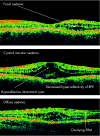The characteristic features of optical coherence tomography in posterior uveitis
- PMID: 17591668
- PMCID: PMC2095553
- DOI: 10.1136/bjo.2007.124099
The characteristic features of optical coherence tomography in posterior uveitis
Abstract
Aim: To describe the different retinal morphological characteristics that can present on optical coherence topography (OCT) in a spectrum of uveitic diseases.
Methods: We reviewed the literature and our own OCT image archive for characteristic features that may be suggestive of a particular disease process.
Results: OCT demonstrates a variety of characteristic morphological changes, some that may point towards a specific disease process. We describe the various forms of macular oedema found in uveitis as well as OCT features typically found in multifocal choroiditis, serpiginous chorioretinitis, toxoplasma chorioretinitis, Vogt-Koyanagi-Harada, sympathetic ophthalmia and the vitreomacular traction syndrome.
Conclusion: Ophthalmologists should be aware of the variety of retinal morphological characteristics that can present on OCT in uveitic disease. Recognition may aid in the diagnostic process, which is complementary to conventional fundal photography and fluorescein angiography. This can facilitate earlier diagnosis and, more importantly, the initiation of specific treatment.
Conflict of interest statement
Competing interests: None.
References
-
- Pons M E, Garcia‐Valenzuela E. Redefining the limit of the outer retina in optical coherence tomography scans. Ophthalmology 20051121079–1085. - PubMed
Publication types
MeSH terms
LinkOut - more resources
Full Text Sources










